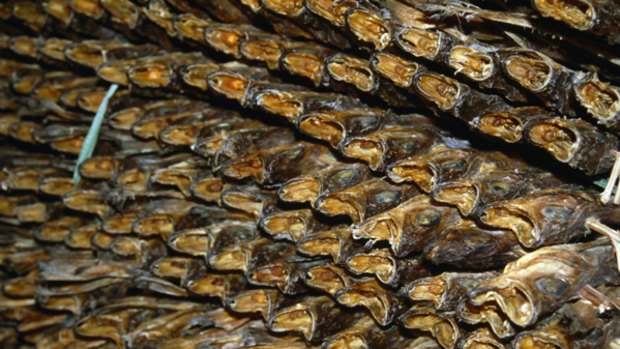
Fish drying at South Korea's Sokcho harbour.Credit: Martin Moos/Lonely Planet
Thanks to a pink aluminium baseball bat, I'll remember this dinner as long as I live. Sokcho, on South Korea's east coast, is not an attractive town. Once a fishing village, it has become a holiday resort catering to tourists who flock across from Seoul, attracted by the beach and nearby national park. The waterfront, like so many in the world, is cursed with a busy road, gaudy signs and ugly buildings.
"Let's not waste much time seeing the harbour," says my local guide, Sonia. "Korean harbours are all the same." I'll take her word for that. She has brought me here for the fish market. Small fish and squid hang drying on racks, stalls sell steaming snacks cooked before our eyes and rows of tanks hold enough weird, writhing sea creatures to stock the Sydney Aquarium.
There are fish and crustaceans of every colour, shape and size. My favourites are the flatfish, the asymmetrical sort where one eye is peering around the edge to see what's happening up on the surface. Then there are puffy orange things that look like bloated octopus tentacles but with hairy roots. And there are pinkish slugs that look like, well, rather like penises. Sonia has a translation dictionary in her mobile phone. The puffy orange things are identified as animal, not vegetable. "Sea squirts," she says, leaving me not much the wiser. Her dictionary doesn't know an English word for the pink slugs but I expect if they really were penises, it would have said so.
A hawker dips her hand into a tank of squirming squid and pulls one out, laying it on the bench.With a razor-sharp knife, she deftly guts it, skins it, chops it into little blocks, lays it in a polystyrene tray, covers it in cling wrap and hands it – still wriggling – to her customer. The whole process has taken less than 20 seconds. It's hard to declare the squid dead yet and I'm still squirming a little myself.
We find a restaurant with a table and chairs. That may sound odd but most diners in this part of the world sit cross-legged on mats and my creaky knees have already had enough of that sort of thing. There's some negotiation with the tough-looking man at the door, carrying that pink aluminium baseball bat. Is this a rough joint? We take off our shoes and shuffle past yoga experts dining on the floor. From the balcony we have a perfect view of a wonderful street show in the market below.
The waitress gives our table a quick wipe and brings a sheet of clear plastic, which she wraps across its surface. I say I'll eat anything, even trying sea squirts and penises. A collection of interesting side dishes appears on the table and Sonia orders "mo-deum hwae", a Korean version of sashimi.
There's a commotion below us. A large flapping fish is tossed onto the street, the tough guy steps forward with that pink baseball bat and clubs it to death. Two minutes later a platter of sliced, raw fish appears at our table. I'm glad I didn't ask for veal.
We dip the strips of fish into bowls of sauce – chilli and wasabi – and wrap them in scraps of lettuce. Delicious. Then there's a fabulous soup made from the head and tail of our fish. The street show below continues. A woman pushing a handcart laden with peaches is blocking the path of a truck with a water tank delivering live fish to the stalls. People chatter, laugh and haggle. Wet money is exchanged.
The sun sets and over by the harbour, squealing fireworks shoot into the sky and explode in clouds of stars. Letting off fireworks is what you do on a beach holiday here, I'm told.
The bill comes and Sonia apologises. "It's so much more expensive to eat by the waterfront," she says. But the damage is less than $20 a head; I've paid more elsewhere to eat ordinary food, without the fabulous dinner show.
The writer was a guest of Korea Tourism Organisation.
TRIP NOTES
GETTING THERE
Cathay Pacific flies from Sydney to Seoul, from $1258. See flightcentre.com.au. Buses from Seoul to Sokcho leave every hour, take about 2 hours and cost 23,000 won ($23) one way.
WHERE TO STAY
Kensington Stars Hotel near Sokcho has double rooms from 116,045 won ($116). For other options, see visitkorea.or.kr.
FURTHER INFORMATION
Sign up for the Traveller Deals newsletter
Get exclusive travel deals delivered straight to your inbox. Sign up now.